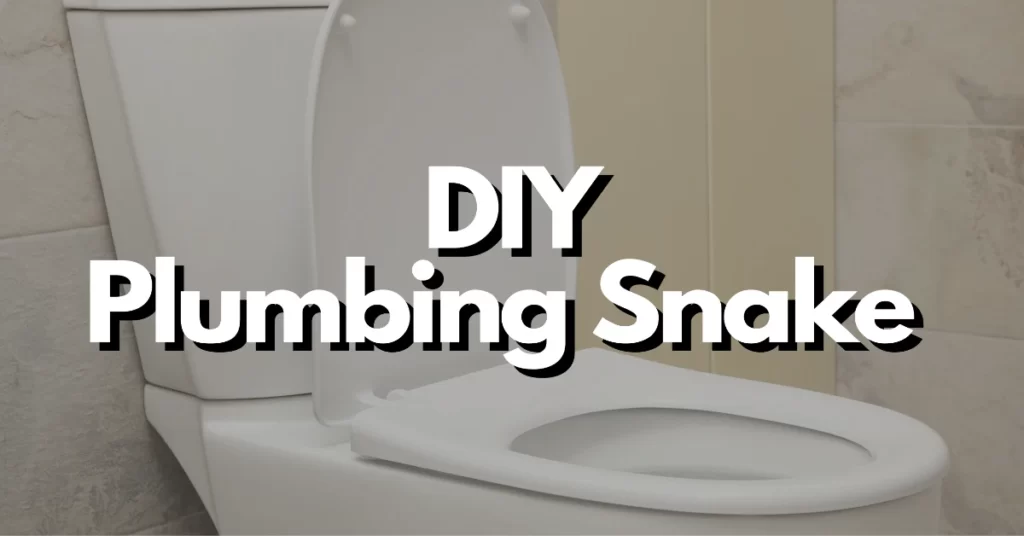Blocked drains are a common household woe. Whether it’s a slow-draining sink or a clogged bathtub, these issues can be frustrating and inconvenient. While professional plumbers have an array of tools at their disposal to tackle such problems, you might be surprised to learn that you can fashion a DIY plumbing snake from items you probably already have in your home.
In this guide, we’ll explore how to create your own makeshift plumbing snake to clear those pesky clogs and save yourself the expense of a plumber’s visit.
Why DIY Plumbing Snakes are Handy
A plumbing snake, also known as a drain auger, is a flexible tool used to dislodge clogs in pipes. It features a long, coiled wire or cable that can navigate through the twists and turns of your plumbing system to break up blockages. While commercial plumbing snakes are readily available, crafting your own can be a cost-effective solution for minor clogs and blockages.
Materials You’ll Need
Before you embark on your DIY plumbing adventure, gather the following household items:
- Wire Hanger: A wire hanger is the backbone of your homemade plumbing snake. Unbend it carefully to create a straight length of wire.
- Pliers: These will help you straighten the wire hanger and shape the tip.
- Tape: Electrical or duct tape will be used to add grip and prevent any sharp edges from damaging your pipes.
- Safety Gear: It’s a good idea to wear gloves and safety glasses to protect yourself from potential splashes and sharp edges.
Creating Your DIY Plumbing Snake
Now that you have your materials ready, here’s how to construct your DIY plumbing snake:
- Straighten the Hanger: Use pliers to straighten the wire hanger as much as possible. You want it to be relatively straight but still retain some flexibility.
- Shape the Tip: At one end of the wire, bend a small hook or loop. This will serve as the tip of your plumbing snake, helping you grab and dislodge clogs.
- Add Grip: Wrap a piece of tape around the end of the wire with the loop to create a soft, rounded tip. This will prevent any damage to your pipes.
- Extend the Length: If your drain is deeper than the wire’s length, you can connect multiple wire hangers together. Simply tape the ends of two or more hangers to create a longer snake.
Using Your DIY Plumbing Snake
With your DIY plumbing snake ready, it’s time to tackle that stubborn clog:
- Insert the Snake: Carefully insert your homemade plumbing snake into the drain, pushing it gently but firmly.
- Rotate and Maneuver: As you feed the snake further, gently rotate it clockwise. This twisting motion will help dislodge and break up the clog.
- Feel for Resistance: If you encounter resistance while pushing or twisting, it likely means you’ve reached the clog. Continue to work the snake back and forth to break up the blockage.
- Retrieve the Clog: Once you’ve broken up the clog and feel that the snake is moving more freely, slowly pull it back out of the drain.
- Dispose of Debris: Be prepared to encounter some debris or hair on the end of your DIY plumbing snake as you remove it. You can dispose of this in the trash.
- Repeat if Necessary: If the drain is still not flowing freely, you may need to repeat the process a few times until the blockage is completely cleared.
- Flush and Test: After successfully clearing the clog, flush the drain with hot water to ensure that it’s flowing smoothly. Test the drain by running water for a few minutes to be certain the clog is entirely gone.
- Safety Considerations
- While creating and using a DIY plumbing snake can be effective for minor clogs, it’s essential to exercise caution and consider safety:
- Protect Yourself: Always wear gloves and safety glasses to safeguard against splashes and protect your hands.
- Don’t Force It: Be gentle when inserting the snake into the drain to avoid damaging your pipes.
- Avoid Sharp Edges: Ensure that the tip of your DIY plumbing snake is well-taped and smooth to prevent any damage to your plumbing system.
- Know Your Limits: For more complex or stubborn clogs, it’s best to consult a professional plumber to prevent further damage or complications.
- When to Call a Professional
- While DIY plumbing snakes are effective for minor blockages, there are situations where it’s advisable to seek professional plumbing help:
- Recurring Clogs: If you’re dealing with persistent or frequent clogs, it could indicate a more significant issue within your plumbing system.
- No Improvement: If your DIY efforts haven’t improved the situation after several attempts, it’s time to call a professional plumber.
- Sewage Backup: If you notice sewage backing up into your drains, it’s a sign of a severe blockage or potential sewer line issue that requires professional attention.
- Old Plumbing: In older homes with aging plumbing systems, a professional plumber’s expertise may be needed to address more extensive issues.
Conclusion
Creating a DIY plumbing snake from household items is a handy skill for tackling minor drain clogs. It’s cost-effective and can save you from the inconvenience of waiting for a plumber.
However, it’s essential to approach DIY plumbing projects with caution, prioritize safety, and recognize when a professional plumber is needed. With the right tools and knowledge, you can keep your drains flowing freely and maintain a smoothly functioning plumbing system.
